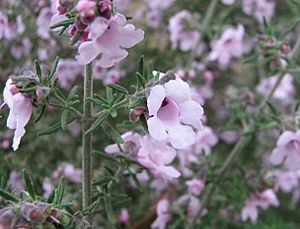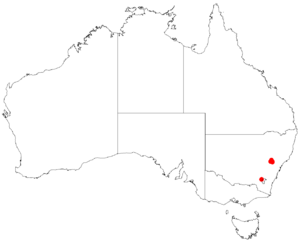Prostanthera stenophylla facts for kids
Prostanthera stenophylla is a special kind of flowering plant. It belongs to the Lamiaceae family, which includes mint plants. This plant is found only in one place: Wollemi National Park in New South Wales, Australia. It's an upright, thin, and fragrant shrub with hairy, oblong leaves. It also has small groups of light bluish-purple to violet flowers.
Quick facts for kids Prostanthera stenophylla |
|
|---|---|
 |
|
| In Maranoa Gardens | |
| Scientific classification | |
| Genus: |
Prostanthera
|
| Species: |
stenophylla
|
 |
|
| Occurrence data from AVH | |
| Synonyms | |
|
Prostanthera sp. Rylstone |
|
Contents
What Does This Plant Look Like?
Prostanthera stenophylla is an upright, thin shrub. It usually grows to be about 1.5 to 2 meters (5 to 6.5 feet) tall. Its leaves are covered with many tiny hairs. They also give off a strong smell, like mint, when you crush them.
The leaves are shaped like a narrow egg or a narrow oval. They look oblong because their edges curve downwards or roll under. The top of the leaves is dull green, and the bottom is paler. Each leaf is about 7 to 14 millimeters long and 1.5 to 2 millimeters wide. They grow on a very short stem called a petiole.
The flowers grow in small groups of four to six. They appear on short side branches where leaves meet the stem. At the base of the sepals (the leaf-like parts protecting the flower bud) are small bracteoles that are 2 to 2.5 millimeters long.
The sepals are 4 to 5 millimeters long and form a tube about 2 to 3 millimeters long. They have two parts, or lobes. The upper lobe is 1.5 to 2 millimeters long. The flower petals are light bluish-purple to violet. They are 8 to 12 millimeters long.
The lower middle part of the petal is 4 to 5 millimeters long and wide. The lower side parts are 3 to 3.8 millimeters long and wide. The upper part is about 4 millimeters long and 8.5 to 10 millimeters wide. It has a small dip or notch in the middle, about 2.5 to 3 millimeters deep. This plant can flower in most months, but it blooms the most in spring.
How This Plant Got Its Name
The plant Prostanthera stenophylla was officially described in 2006. This was done by Barry Conn, a scientist from the National Herbarium of New South Wales. He wrote about it in a science journal called Telopea. He used plant samples collected near Dunns Swamp in 1996.
Barry Conn thought this plant was related to the granite mintbush (Prostanthera granitica). The granite mintbush looks similar. However, it has stiffer, rougher hairs and wider leaves.
The first time someone collected this plant was in 1952. This was done by a plant expert named George Althofer. Another collection from 1937 by Lindsay Pryor is also this species. But the place where it was collected, the "Canberra district," is likely incorrect. The name stenophylla means "narrow-leaved." This refers to the plant's thin leaves.
Where Does It Grow?
This special mintbush is only found in the Wollemi National Park in Australia. It grows in a type of forest called a sclerophyll forest. This forest has trees like black cypress pine (Callitris endlicheri), snappy gum (Eucalyptus rossii), and Sydney peppermint (E. piperita).
The plant prefers to grow on sandstone outcrops. These are rocky areas that people sometimes call 'pagodas' because of their shape.
Growing It in Gardens
This plant has been grown in gardens a little bit for some years. Plant nurseries have sometimes used the unofficial name Prostanthera rylstonii for it since at least 2005.

